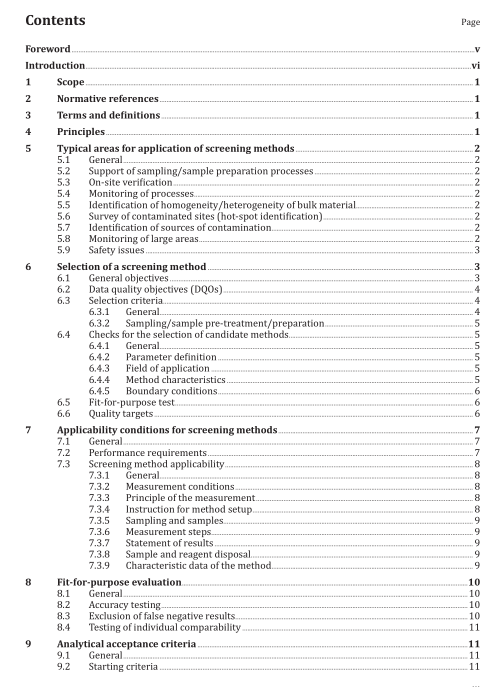ISO 12404:2021 pdf download.Soil and waste — Guidance on the selection and application of screening methods
6 Selection of a screening method
6.1 General objectives
Before the screening of a site can be carried out, a thorough planning phase is necessary.
First, all information available about the site should be evaluated, often by conducting a preliminary investigation such as desk study and site reconnaissance following, for example, ISO 18400-202. This may include historical records or data available from previous investigations. Essential prerequisites for the suitable preparation of a screening investigation is information about the hydrogeological situation, the kind of contaminants and/or parameters of interest and the concentrations or values likely to be expected, as well as any information about the locality, including the former use of the site. Furthermore, the infrastructure of the site and the accessibility might need to be taken into consideration.
NOTE 1 Further additional steps can be considered:
— development of a conceptual site model (see e.g. ISO 21365);
— development of a suitable sampling strategy (see e.g. ISO 18400-104, and ISO 18400-203 or ISO 18400-205,as appropriate);
— preparation of a sampling plan (see e.g. ISO 18400-101).
NOTE 2 Further information relevant to development of sampling strategies can be found in e.g. ISO 11504,ISO 15175, ISO 15176, ISO 15799, ISO 15800 and ISO 19258.
When the target field is waste, a similar approach is advised. Information about sampling strategies and planning can be found in e.g. CEN/TR 15310, Part 1-5.
NOTE 3 For full titles of the documents listed above, see Bibliography.
Taking into account this background information, data quality objectives should be defined that determine the applicability of the screening method. Only with these preliminary steps the selection of screening methods is possible.
Some examples of detailed questions are listed below. This list is not exhaustive and not all might be relevant for a specific site:
— parameters and analytes of interest;
— matrices of interest and condition and variability of matrix;
— data quality objectives (see 6.2 for the details);
— parameter values known, expected or already found on-site;
— statistical probability;
— ease of sampling;
— site facilities;
— site area;
— number of results per time unit;
— health and safety considerations.
An example for the selection and application process of screening methods to soil contamination is given in the informative Annex A.
An example for typical results on finding hot spots by screening methods is given in the informative Annex B.
6.2 Data quality objectives (DQOs)
NOTE The data quality objectives (DQOs) process refers to a systematic planning procedure for environmental data collection so that the data can be defensibly interpreted, and statistically analysed where appropriate, to address specified objectives. It includes appropriate sampling design and sampling plans, as well as the analytical strategy and setting analytical data objectives [21] . The concept applies not just to numerical data, but also to the sufficiency of all relevant information in terms of quantity, quality and type.
In land contamination investigations, there are typically DQOs that require laboratory analytical data to be meaningfully comparable to a variety of risk-based or other quality criteria.
DQOs should be set for all investigations. They should be defined for the specific purpose of the site investigation phase or activity, e.g. risk-based assessment (human health and controlled waters),remediation, validation or waste classification.
When setting DQOs, account should be taken of the type, quantity and quality of the data required to inform subsequent decisions based on the data and other available information.
DQOs should be set having regard to QA/QC (Quality Assurance/Control) requirements and how comparison with risk-based or other criteria is to be effectively supported by the site data and information as well as the laboratory analytical data collected.
Review points should be identified at key stages throughout the investigation, assessment and remediation design phases to ensure that DQOs remain aligned to the project requirements. The review should include assessment of the continuing validity of the conceptual site model, data consistency,emerging data gaps and levels of uncertainty. A written record of the review should be maintained and incorporated in the assessment and design process and include a statement on whether the DQOs have been met and any shortfalls within the assessment.ISO 12404 pdf download.ISO 12404 pdf download
